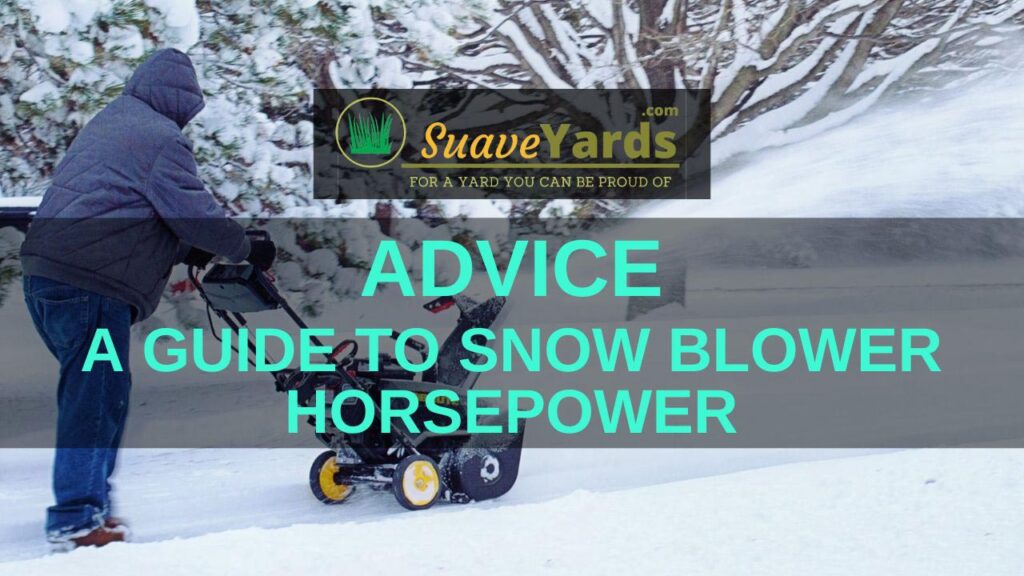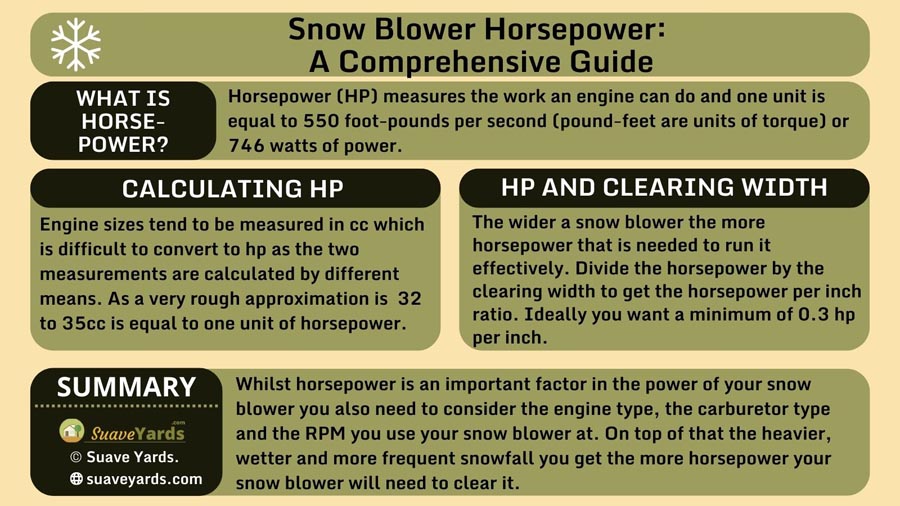
Snow blower horsepower – What is it? Is it important? How do you calculate it? How many cc to one unit of horsepower? Why aren’t snow blower engines measured in horsepower anymore?
So many questions, such complicated answers… For the most part.
Snow blower horsepower is a confusing subject (well I think it is anyway!). And it certainly isn’t the be-all and end-all when it comes to buying a snow blower.
So in this blog, we will try our best to answer some of the most commonly asked questions about horsepower and explain it in more detail.
Let’s get started.
Snow Blower Horsepower: How Much Do I Need?
The wider the snow blower is, the more horsepower it needs. You want to work to a ratio of at least 0.3 horsepower per inch. There are also a number of other factors that influence the power of a snow blower, such as the engine type, the carburetor type and the RPM that you use it at. It doesn’t all come down to horsepower.
What is Horsepower?
In short, horsepower measures the work an engine can do.
One unit of horsepower can officially be defined as:
- 550 foot-pounds per second (pound-feet are units of torque).
- 746 watts of power
All snow blower engines used to be measured in horsepower, but that has all changed in the past decade (more about that below) and now they are measured in cc (cubic centimeters).
CC is a measure of the engine displacement, that is the amount of volume moved by the pistons in a single revolution of the engine.
The problem is cc and horsepower are calculated entirely differently, which makes it very difficult to accurately equate one to the other.
And then on top of that, not all horsepower is equal!
For instance, I have an uncle with an old John Deere Model 40 tractor and a standard garden tractor that are the same horsepower.
However, having driven them both I can say for definite that the Model 40 tractor is much stronger.
And that is because whilst horsepower is a factor, the true power of an engine is also influenced by a number of other factors such as:
- The engine type (overhead valve engines tend to have more power than side valve engines).
- Carburetor type (turbo, fuel injected, etc etc)
- The RPM you use it at
What is generally true is, the bigger is better.
So if you are on the fence when it comes to the power of an engine, I would always go for the bigger-sized engine to be on the safe side.
RELATED ===> Buyers Guide: The Best Snow Blowers on the Market
Why Are Snow Blowers No Longer Measured in Horsepower?
At the end of the 2000s pretty much every snow blower sold in the US, was measured in horsepower.
That meant you could quickly and easily compare the power of various models.
But then there was a lawsuit was brought against a number of small engine manufacturers.
The claim was that they were overstating the horsepower of the engines, and they weren’t meeting the suggested horsepower levels.
So for fear of litigation, in around 2012, most manufacturers began measuring power in gross torque.
The problem was no one really understood what that meant. So manufacturers changed tact again and began using cc.
That means today you will still find a handful of manufacturers (such as Honda) using hp, some use gross torque, and most use cc.
It makes comparing engine power much more difficult!
How Do You Calculate Horsepower?
There is not a 100% accurate way to convert cc to horsepower, because, as previously mentioned, the two measurements are calculated by different means.
But there are a couple of ways you can roughly approximate much cc to horsepower.
First of all, you could use the FindnChoose HP Calculator website.
Secondly, you could use the formula on the Briggs and Stratton website, which is: engine rpm x torque ÷ 5,252.
The problem with this is you need to have the relevant figures to hand and finding the engine rpm and torque is not always easy.
Finally, the easiest way if you want to calculate it manually is that 32 to 35cc is very roughly equivalent to 1 unit of horsepower.
Based upon the last calculation that gives the following:
- 3 HP = 96cc to 105cc
- 5 HP = 160cc to 175cc
- 8 HP = 256cc to 280cc
- 10 HP = 320cc to 350cc
- 12 HP = 384cc to 420cc
- 15 HP = 480cc to 525cc
As I say that is a very rough approximation, and as previously noted there are many other factors that come into play.
RELATED ===> Why Are Snow Blowers So Loud?
Snow Blower Horsepower and Clearing Width
There is a direct correlation between the clearing width of a snow blower and the horsepower needed to run it effectively.
In essence, the wider the snow blower, the greater horsepower that is needed.
How do you know the horsepower you need for the width of your snow blower?
Simply divide the horsepower by the clearing width to get the horsepower per inch ratio.
You want a minimum of 0.3 horsepower per inch.
So scenario one, you have a 5-horsepower snow blower with a 20-inch clearing width:
5 ÷ 20 = 0.25 horsepower per inch
That is a fairly weak ratio.
In scenario two let’s say you have a 10-horsepower snow blower with a 26-inch clearing width:
10 ÷ 26 = 0.385 horsepower per inch
That will give you more power removing snow than the 5-horsepower snow blower.
The ratio becomes more important as horsepower increases.
What Else Do I Need to Consider Apart from Horsepower?

Earlier on in the blog, we mentioned how things like the engine and carburetor type and the rpms are also a factor in the power of a snow blower.
So there is more to consider than just horsepower.
For instance, how much and what kind of snow do you usually get?
If you are likely to never need to clear more than a couple of inches of snow, then horsepower is not really an important factor.
If you will regularly need to clear wet, heavy snow then you will want a snow blower with sufficient power to do it quickly and easily.
How frequently does it snow?
Again if you get prolonged winters, you want a well-powered snow blower that will see the season through with minimal fuss.
Also, consider the weight of the snow blower itself.
If you have a snow blower that is relatively lightweight that might seem great for maneuvering it around your drive, but you could find it slips as it encounters hard-packed snow.
A heavier snow blower will certainly have more pushing power. More horsepower usually does mean more weight.
More horsepower also means a faster ground speed, less clogging and snow being thrown further with less struggle.
But also as the horsepower increases, the blower will become heavier, bigger and bulkier.
As alluded to previously the engine plays an important role in the power of the machine.
Better-designed engines will have more power and more torque, which is as important as, if not more important than, horsepower.
RELATED ===> Are Toro Snow Blowers Better Than Ariens?
So How Much Horsepower Do I Need On My Snow Blower?
I know that despite everything, lots of people at least want a starting point to work from when they are considering what snow blower to buy.
I think an 8hp walk-behind snow blower will probably have enough power to meet the vast majority of homeowners’ needs.
Going into a bit more detail and starting with a 5hp snow blower.
A 5hp snow blower with a 22-inch clearing width should be a good match. A 5hp 24-inch snow blower will most likely be fine for light snow, but might struggle with heavy snow.
A 5hp, 26-inch snow blower will simply be too wide, unless you are clearing very light snow.
Moving up to an 8hp snow blower, I would never go for anything more than a 26-inch wide machine, and 24-inch wide blower would also be a good match.
Up one more notch to a 10hp snow blower, and the optimum width here is 28-inch to 30-inch. When you get up to a 32-inch clearing width you will be pushing it in wet, heavy and deep snow, although in lighter snow it might be ok.
Not many of us will need a 12hp to 15hp machine, but they can easily clear 32-inches to 36-inches with no problem.
A 15hp snow blower with a 42-inch clearing width should be ok for light to moderate snow.
Final Thoughts

As you can see, horsepower is a slightly confusing subject, both trying to calculate it and trying to figure out how much horsepower your snow blower needs!
On top of that, there are a whole number of other factors that come into play when considering the power a snow blower can generate and the amount of snow it can easily deal with.
It isn’t all about horsepower.
One thing that is universally true though is the wider a snow blower the more horsepower it will need.
It is a slightly complicated subject, but I hope this has cleared things up a bit.
If there is anything I have not covered that you feel I should have done, drop me a comment below.
